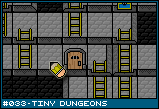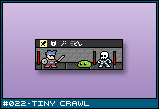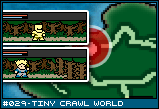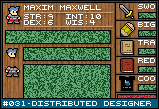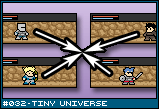| Three Hundred |
| - Index Page |
| - About... |
| - By Year |
| Collections |
| - Comp-Grid |
| - Procedural |
| - Tactics |
| - Tiny Crawl |
| - Misc |
| Previous | Mechanic #033 | Next |
Extending from [#032 - Tiny Universe], this entry is about your ability to create a dungeon for your Tiny World that you can then publish so that your buddies can play through it.
![[dm1.png]](set02/img/entry033-dm1.png) Creating a dungeon begins by finding a Dungeon Master character. This is a special character you must first locate, and they differ in appearance and ability based on which zone they are found in. So a swamp Dungeon Master will be different from a Dungeon Master in charge of a cave or castle. A Dungeon Master is a character like any other, and can be sent around to various locations around the world and fight monsters and what not. But the Dungeon Master also has some special abilities. The first is that he comes with his own dungeon. Once you've added him to your roster, you can modify or publish the dungeon he was found in. You may also rebuild it from scratch if you wish. The second thing is that the Dungeon Master comes with special abilities that affect how that dungeon can be built. For instance, he may have a Traps ability of 4, which allows him to place up to four traps in his dungeon. These can affect everything from the type of monsters he can control, how many rooms can be built, which rooms are available, how many floors the dungeon can contain, and so on. These stats go up along with the level of the Dungeon Master, so you can increase your ability to design his dungeon by letting him kill enemies. These are different for each Dungeon Master, so you could build up a Dungeon Master and then trade it to a friend for his.
![[map1.png]](set02/img/entry033-map1.png) Once you have a dungeon, you can edit it through a simple level editor. You can use [#004 - Environment Tree] to spot check it to make sure that it is winnable for other players. Then you can publish the dungeon to your buddy, or perhaps just send in your own units to play around in it.
![[loot1.png]](set02/img/entry033-loot1.png) The dungeon is populated with loot the Dungeon Master collects somehow. He can either find loot himself through dungeon exploration or hire other units for a certain amount of money for a certain amount of time, and any loot they find will automatically be placed into the dungeon's treasure room. All loot in the dungeon is taken from the treasure room, but chests are placed in the level according to loot type. So, you could place an armor chest in the level and when opened, a piece of armor will be selected from all the available armor pieces in the treasure room. Keeping the treasure room well stocked is important, because if a unit opens a chest and the appropriate treasure is not available, he will receive gold from the Dungeon Master's coffers. The Dungeon Master's level greatly affects how large and varied a dungeon can be. Depending on the size of the dungeon, there will be a minimum number of chests required from each of the categories. If you add chests above and beyond the minimum, you may be able to add additional rooms or monsters to the dungeon, increasing it beyond what the Dungeon Master would be typically capable of.
Monsters are trained and added to the dungeons. You can only add a certain number of monsters to the dungeon, unless you add additional chests to increase that number. You do not place monsters. Instead, you just add them to the dungeon and they will wander around by their own accord. The one exception is the single BOSS monster you can add to the dungeon, who will always reside in the last room. In order to facilitate balance, you do not train monsters in level and ability. Instead, all monsters are automatically scaled to the level of the dungeon, and their abilities are dependent on which type of monster they are and their level. When training monsters, you are instead trying to affect them so that they change classes into different types of monsters. ![[monster1.png]](set02/img/entry033-monster1.png) Each monster has a few different moves that it can use, and you can set the priority of each one to rarely, normally, or frequently. Each time these moves are used, the move count is incrimented by one. Each time the move is used to defeat an enemy, the move count is incrimented by two. Depending on which moves are improved, the monster will be able to do a class change when a certain point is reached (like X points are raised). Monsters come in specific groups and have a specific tree of possible classes they can transform into, but all monsters begin as a root monster. For instance, all human monsters begin as a slave while animal monsters start as a slime. The dungeon master is able to purchase a root monster from town and then either raise them himself, or give them to a trainer to raise. There is a different trainer for each root monster, like a Beast Master or a Slave Master. These guys come with a specific camp they have where they can house five or six different monsters. This camp can is attached to a town, and can be upgraded with money based on the level of the Monster Trainer. Additional facilities can be added like swimming pools, sparring arenas, weight rooms, and so on which can help monsters focus on specific attributes. The monsters can also be sent to dungeons to level up as well. Once the trainer has trained a monster to a specific class, he can then offer them for sale and either Dungeon Masters or other trainers can purchase it, or visiting units from buddies.
|
